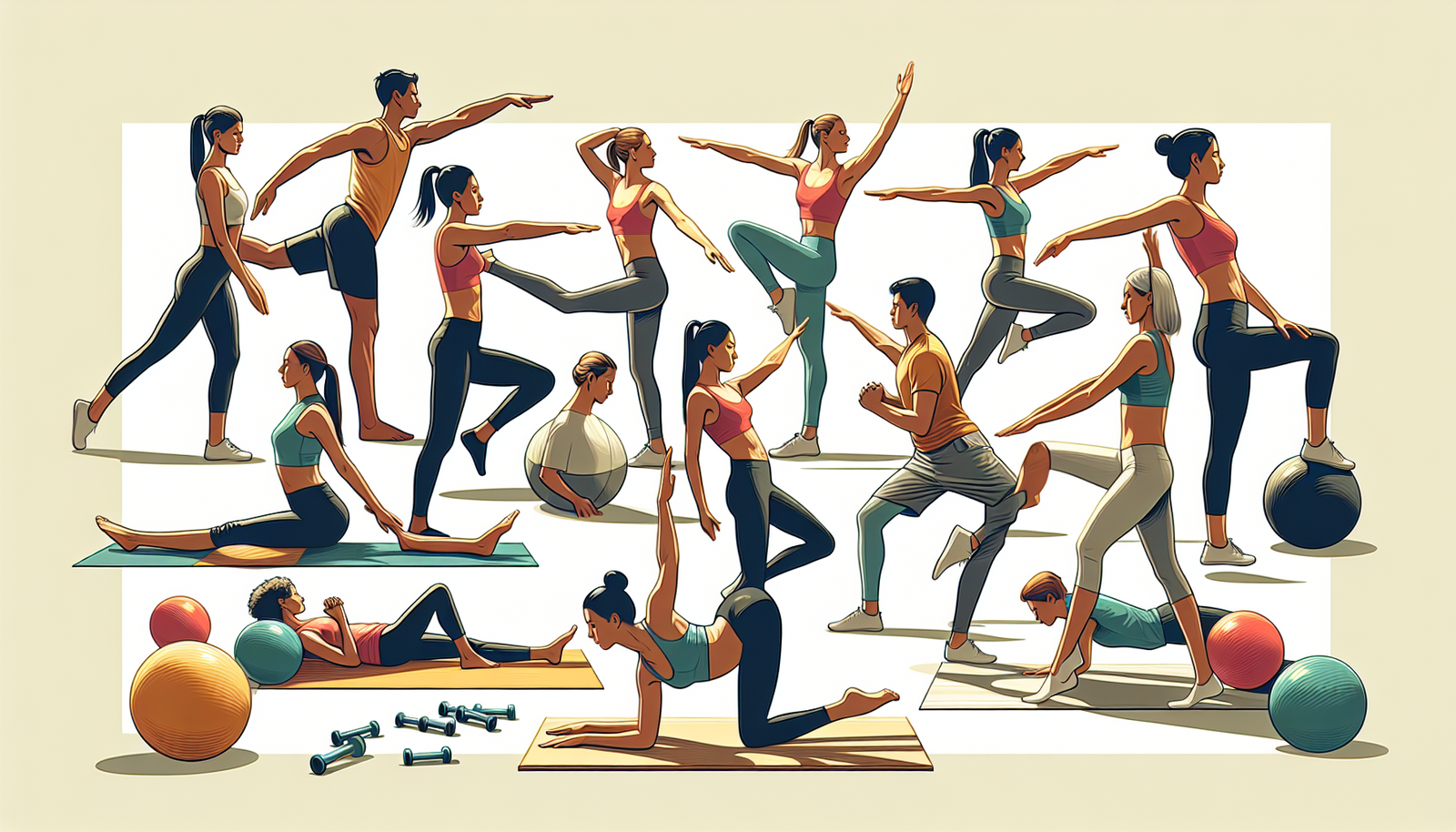The article “Exercises to Improve Balance” provides an insightful exploration into the realm of health and fitness, specifically targeting exercises that enhance balance. With a keen focus on improving physical stability, the article aims to equip readers with practical and effective strategies to enhance their overall well-being. By delving into a range of exercises tailored to strengthen core muscles, enhance coordination, and promote proprioception, this article serves as a valuable resource for individuals seeking to enhance their balance and stability.
Exercises to Improve Balance

Overview of Balance Exercises
Balance exercises are a crucial component of any fitness routine, regardless of age or athletic ability. These exercises help improve stability, coordination, and overall body control. By challenging our balance, we can enhance our proprioception and reduce the risk of falls or injuries. In this article, we will explore various types of balance exercises, including standing, seated, and dynamic exercises, as well as exercises tailored for older adults and athletes.
Benefits of Balance Exercises
Engaging in regular balance exercises offers numerous benefits for our physical and mental well-being. Firstly, these exercises improve our ability to maintain balance, which is vital for everyday activities like walking, climbing stairs, or even standing for prolonged periods. By developing better balance, we reduce the risk of falls and injuries, particularly for older adults.
Additionally, balance exercises enhance our overall body coordination and kinesthetic awareness. They challenge our muscles, joints, and nervous system to work together harmoniously, leading to improved movement efficiency. Moreover, these exercises can help in correcting postural imbalances and strengthening core muscles, leading to better posture and spinal alignment.
From a mental perspective, balance exercises also promote focus, concentration, and mindfulness. As we strive to maintain equilibrium, we train our minds to stay present and attuned to our bodies’ sensations, fostering a mind-body connection.
How to Get Started
Before starting any new exercise program, it is crucial to consult with a healthcare professional, especially if we have any pre-existing medical conditions or injuries. They can provide individualized advice and ensure that the exercises we choose are suitable for our specific needs.
Once we have the green light from our healthcare provider, we can begin incorporating balance exercises into our routine. It is essential to start with exercises that match our current fitness level and gradually progress as we gain strength and stability. Always remember to warm up before beginning any balance exercises to prepare our muscles and joints for the movements.
Standing Balance Exercises
Standing balance exercises are an excellent starting point to improve our balance. These exercises primarily focus on challenging our ability to maintain stability while standing on one or both legs. Here are some examples of standing balance exercises:
1. Single Leg Stance
To perform the single-leg stance, stand straight, lift one leg off the ground and hold the position for 30 seconds to a minute. Switch legs and repeat. As we progress, we can challenge ourselves by closing our eyes or performing small movements while balancing on one leg.
2. Wall Sit
The wall sit exercise not only targets our leg muscles but also improves balance. Start by standing with your back against a wall, then slide down to a seated position with your knees at a 90-degree angle. Hold this position for 30 seconds to a minute, engaging the thighs and core muscles. Gradually increase the hold time as our strength improves.
3. Heel-to-Toe Walk
The heel-to-toe walk is a simple yet effective exercise for improving balance. Put one foot in front of the other so that the heel of the forward foot touches the toe of the rear foot. Take slow, deliberate steps, focusing on maintaining balance throughout the movement. This exercise can be performed on a straight line or a narrow beam for added difficulty.
4. Standing Yoga Poses
Yoga poses such as the Tree Pose or the Warrior Pose are great for improving balance. These poses challenge our stability, flexibility, and concentration. Start with simpler variations and gradually progress to more advanced poses as our balance improves.

Seated Balance Exercises
Seated balance exercises are suitable for individuals who may have difficulty standing for extended periods or those who prefer to work on balance while seated. These exercises target core muscles and promote stability. Some seated balance exercises include:
5. Seated Leg Raises
While seated in a chair, extend one leg straight out in front of you and hold for a few seconds. Lower it back down and repeat with the other leg. This exercise strengthens the core muscles and improves balance and stability.
6. Seated Twist
Sit tall in a chair with your feet flat on the ground. Slowly twist your upper body to one side, placing one hand on the outside of the opposite thigh. Hold for a few seconds, then return to the center and repeat on the other side. This exercise targets the core and improves rotational stability.
7. Seated Marching
While seated, lift one knee towards your chest, then lower it back down. Alternate between legs, mimicking a marching motion. This exercise strengthens the hip flexors and core muscles, promoting better balance and stability.
8. Seated Weight Shifts
Sit upright with your feet flat on the ground. Shift your weight from side to side, lifting one buttock off the seat slightly while keeping the other buttock grounded. Repeat this movement, focusing on maintaining control and balance. This exercise targets the core and hip muscles, improving stability and balance.
Dynamic Balance Exercises
Dynamic balance exercises involve movements that challenge our equilibrium while incorporating controlled motions. These exercises mimic real-life scenarios and activities, promoting functional balance. Here are some dynamic balance exercises to try:
9. Lunges
Lunges are excellent for improving dynamic balance and lower body strength. Begin by standing with one foot forward and the other foot placed back. Bend both knees to lower the body towards the ground, keeping the front knee directly above the ankle. Push through the front foot to return to the starting position, then repeat on the other side.
10. Side Leg Raises
Stand with your feet hip-width apart, then lift one leg out to the side while maintaining balance. Control the movement as you lower the leg back down and repeat on the other side. This exercise targets the hip abductor muscles, enhancing stability. For an added challenge, perform the leg raises while standing on an unstable surface.
11. Step-Ups
Using a step or a sturdy platform, place one foot on the elevated surface. Push through the heel of the elevated foot to lift the body up, then step back down and repeat with the other foot. Step-ups improve balance, leg strength, and coordination.
12. Balance Board Exercises
Balance boards are a versatile tool for improving balance. Stand on a balance board and focus on maintaining stability as the board moves beneath our feet. As we progress, we can try performing exercises such as squats, lunges, or single-leg stands on the balance board to further challenge our balance and coordination.
Balance Exercises for Older Adults
Maintaining good balance is especially crucial for older adults to prevent falls and maintain independence. Here are some balance exercises that are specifically beneficial for older adults:
13. Toe Stand
Stand near a wall or a sturdy surface for support. Rise up onto your tiptoes, then slowly lower yourself back down. This exercise strengthens the calf muscles, which play a vital role in balance and stability.
14. Calf Raises
Stand tall with your feet hip-width apart. Lift your heels off the ground, rising onto the balls of your feet. Slowly lower the heels back down. Repeat this movement to strengthen the calf muscles and improve overall balance.
15. Tandem Walk
With your arms extended to the sides for balance, take alternating steps, placing the heel of one foot directly in front of the toes of the other foot. Walk in a straight line, focusing on maintaining balance and control throughout the movement.
16. Tai Chi
Tai Chi is a gentle and low-impact exercise that combines flowing movements and deep breathing. This ancient Chinese practice improves balance, flexibility, and overall well-being. Joining a Tai Chi class or following instructional videos can be an excellent way for older adults to enhance their balance and promote relaxation.
Balance Exercises for Athletes
Athletes, regardless of their chosen sport, can greatly benefit from specific balance exercises that enhance agility, coordination, and reactive capabilities. Here are some balance exercises tailored for athletes:
17. Bosu Ball Exercises
The Bosu ball is a fantastic tool for challenging balance and stability. Perform exercises such as squats, lunges, or single-leg stands on the Bosu ball to engage the muscles and promote dynamic balance.
18. Plyometric Exercises
Plyometric exercises, which involve explosive movements, are excellent for developing power and reactive balance. Exercises like box jumps, lateral bounds, or depth jumps enhance proprioception and dynamic stability.
19. Single-Leg Jumping
Jumping on one leg is an effective exercise for athletes to improve balance and lower limb strength. Start with small jumps and gradually increase the height or distance as you progress.
20. Stability Ball Exercises
Incorporating a stability ball into your workouts can greatly challenge balance and core stability. Performing exercises like stability ball push-ups, hamstring curls, or planks on the ball engages various muscles and promotes overall body control.
Safety Tips for Balance Exercises
When performing balance exercises, it is essential to prioritize safety and prevent unnecessary injuries. Here are a few safety tips to keep in mind:
- Always warm up before attempting balance exercises to prepare the muscles and joints for the movements.
- Begin with exercises suitable for your current fitness level and gradually progress as you gain strength and stability.
- Make sure to have a sturdy object nearby, such as a wall or chair, to provide support if needed.
- Use proper footwear with adequate grip and support to prevent slips or falls.
- Focus on maintaining proper form and technique throughout each exercise to maximize effectiveness and reduce the risk of injury.
- If you have any pre-existing medical conditions or injuries, consult with a healthcare professional before starting any new exercise program. They can provide personalized advice and recommendations.
Conclusion
Improving balance is a crucial aspect of any fitness journey, regardless of age or athletic ability. By incorporating balance exercises into our routine, we can enhance stability, coordination, and overall body control. Whether we choose standing, seated, or dynamic exercises, the benefits of balance training extend beyond physical fitness and contribute to our mental well-being as well. Remember to always prioritize safety and gradually progress as your balance and strength improve. So, let’s get started on our journey towards better balance and overall fitness!

